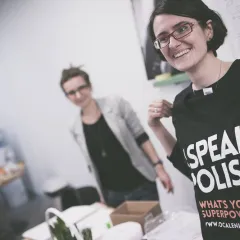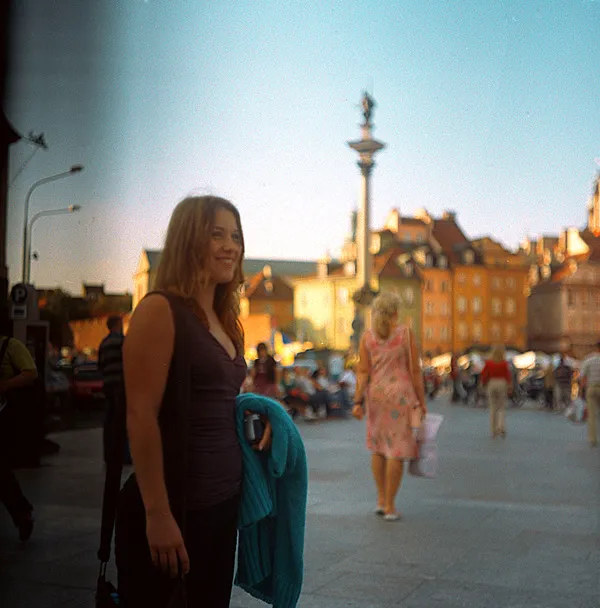Kindly, winter had finally gone away. Spring came and I took my daughter for a walk. We took a bus to Krakowskie Przedmieście to enjoy the sunshine, and then we walked from the University towards Starówka. Just recently I had got a new mobile phone for 1 zloty. Providers had been competing with each other to win customers which resulted in an offers’ overload. When you have a new phone, you really feel like taking pictures. It was just after the pope’s beatification and there was a giant image of John Paul II hanging in front of St. Ann’s Church. My daughter Daba, instead of waiting patiently for me to take a picture, was all over the place but finally I managed to take it. I checked if it was clear enough to keep it and then, to my surprise, I discovered that the king had got into my frame! The king has been ruling the Castle Square (Plac Zamkowy) for centuries. I had caught the majesty’s column. The picture was great – my small Daba and the high column with the statue of King Zygmunt III Vasa. Suddenly a thought (or rather a question) came to my mind whether there is a street named after King Zygmunt III Vasa in Warsaw. Prince Poniatowski has a bridge and a monument, King John III Sobieski has his street and even a hotel, the Pope has his avenue, the generals like Bem, Anders and De Gaulle have their roundabouts....There are even funny streets like Pineapple or Gallop Streets. I heard that there was a poll conducted among children that decided about naming one of the streets Winnie-the Pooh Street. Even Universe and Mars have their streets... so what about King Zygmunt III Vasa Street?
King Vasa looks at us every day and night from a royal height of 22m. Everyone who has walked around the famous Castle Square knows the place where the column is situated. The tourists and pupils at school trips seem to be the only people looking high up and trying to find a monarch at the top of the column. I guess the Warsaw residents stopped looking at the king who towers over the square.
There is a possibility that if it wasn’t for the Royal Highness I would have been studying in Kraków. When I came to Poland from Senegal at the beginning of 1980s, I thought that the best of everything can be found only in the capital. This is still the reality in many African countries. Therefore if Zygmunt hadn’t moved his entourage from Małopolska to Mazowsze and hadn’t become a permanent Warsaw resident, I could have ended up in Krakow. According to Prof. Tazbir: “The column was erected to commemorate the king but it didn’t receive the gentry’s approval until much later. At that time nobody assumed that one day it would become a symbol of Warsaw. But that’s what happened. None of the other monuments of Warsaw got so much attention in poetry, paintings or graphics.” People who have been widely recognised, respected and admired in Poland, have their palaces, roundabouts, parks, monuments, avenues and streets. I came to the capital in mid 1990s when streets and other public places were in the process of changing their patrons. And I mean many of them. One of the streets changed by the local authorities was named after our beloved African Prime Minister Patrice Lumumba. Even the Congolese president said that Lumumba wasn’t a communist. It didn’t matter that he was liked by the wrong political camp in Eastern Europe. When I took a language course in Łódź, I lived on the street named after him. It’s a shame but in Warsaw there is only one African Street, in Saska Kępa. The whole African continent was treated unfavourably. Who knows, maybe one day people like Mandela and Desmond Tutu will get their names on the navy blue and red signs of the capital’s streets.
Let’s get back to the king’s column. I read that it’s the oldest secular monument in Warsaw. Before 1644, when a son funded the column for his deceased father, only saints had this privilege. Supposedly the Church was very upset about the fact that a secular person (it didn’t matter that he was a religious king!) was recognised in such a distinguished way.
History is a beautiful subject. My favourite Prof. Tazbir says about the king: “He seemed to be beautiful but there wasn’t anything Jagiellonian or Polish about him. He was somehow a little bit of Spanish, Swedish and foreign, despite the fact that he could speak Polish slowly but clearly and beautifully...”
In Warsaw there are around 6 000 streets, avenues, roundabouts and squares. King Zygmunt III still doesn’t have neither a street nor a square or roundabout. Poets wrote that he wasn’t a great king but they loved the column. The beginning of the 1990s was revolutionary for streets’ names – old names were reintroduced and those associated with communists were replaced by names linked to other services. How did it happen that the city forgot about the king who “decided” that I studied in Warsaw and that I’m still living here? Is it the Royal Street that was supposed to commemorate the King?
In Poland there are so many public celebrations but it turns out that none of those taking place in Zygmunt’s times have been recognised in present times. It’s ok, though. The column has been the capital’s symbol for a long time. There is a lot happening in its surrounding area every day, at public holidays, in winter or summer. I can imagine a navy blue and red sign displaying the name of King Zygmunt III Vasa Street. That makes me think of a double role for this king, who came from Sweden, being the patron of this street but also the patron of immigrants.
Mamadou Diouf
Translated by: Anna Martinsen

















